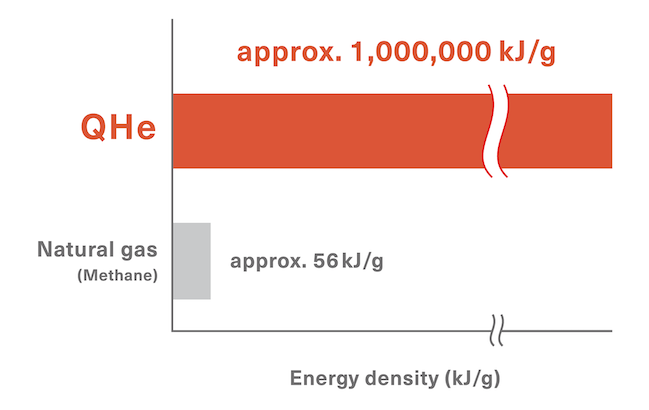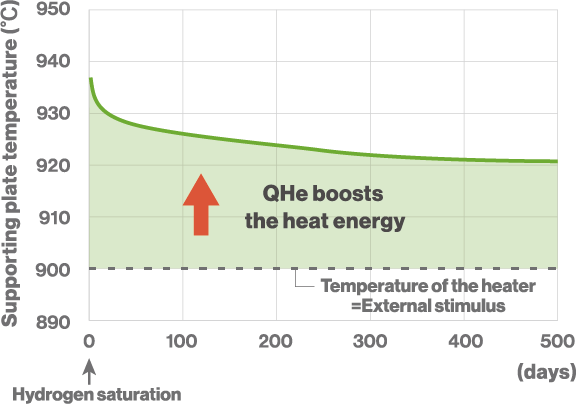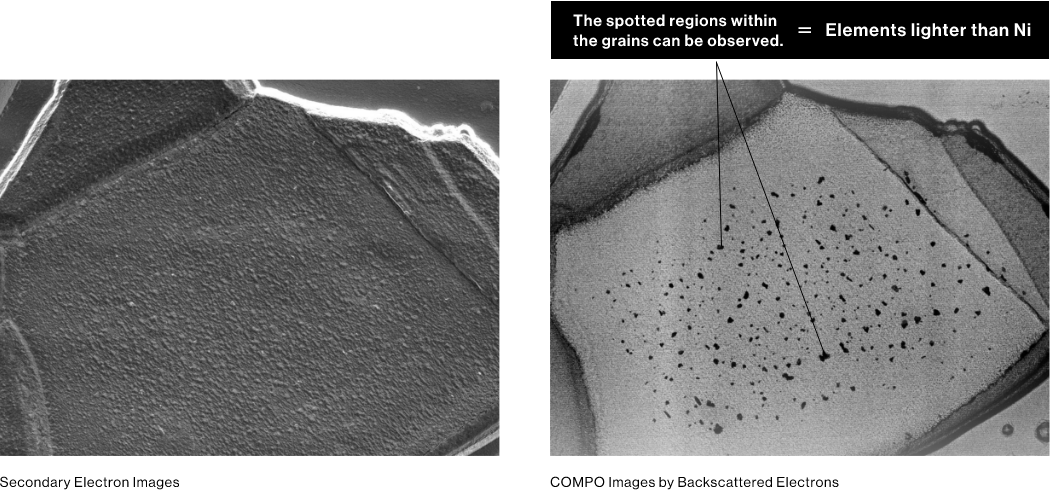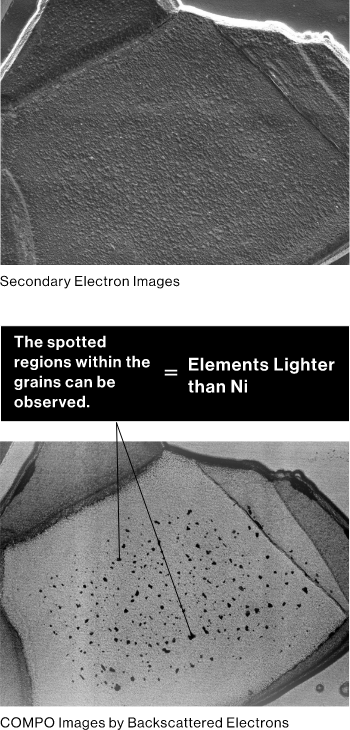QHe TECHNOLOGY
QHe
TECH-
NOLOGY
What is the heat
generation phenomenon of QHe?
QHe is a heat-generating technology with hydrogen quantum diffusion. The diffusion is induced by heating a small amount of hydrogen saturated in nano-sized nickel-based composite material.

QHe’s energy density is more than 10,000 times higher than natural gas
QHe’s heat density per gram of fuel is much higher than that of chemical reactions such as methane (natural gas) and hydrogen combustion. With QHe, less than 10 grams of hydrogen are needed to power the monthly electricity and heat needs of a household.

QHe can run continuously following initial absorption of hydrogen
In one of our experiments, excess heat was observed for 589 days from May 7, 2021, to Dec. 18, 2022, with hydrogen saturation only at the beginning of the experiment.

Potential of QHe
QHe can provide industrial-scale heat up to 1,000°C. The technology operates with nano-sized nickel- based composite material and a small amount of hydrogen. The technology has been developed with Tohoku University, the top runner in this field. QHe is a breakthrough technology for the world to go net-zero.
Clean Planet is currently engineering QHe-powered heat modules that can provide energy to the industrial, commercial, transportation, and residential sectors. Clean Planet is developing a pilot industrial boiler with Miura Co., Ltd., the Japanese leading industrial boiler company, using QHe-powered heat modules as the heat source to market boilers in a near future.
QHe-powered heat modules are applicable to power generation, manufacturing factories, steel and chemical industries, agriculture, direct air capture, and water desalination.
Our Patents
Clean Planet has been strategically building its patent portfolio since 2013, including principal patents in heat generation using Quantum Hydrogen Energy, and related technologies such as reaction control, nano-sized reactant material production, and heat-utilizing applications.

# of patents
filed
272
# of patents
granted
113
# of
countries
23
Roadmap for Commercial
Application
2012 - 2018
PHASE
01
Basic research at academic institutions
- Joint Research Center with Tohoku University established (2015 -)
- NEDO project confirmed excess heat generation and reproducibility
2019 - 2021
PHASE
02
Preparation for
commercialization
- R&D of various prototypes for commercialization
- Building patent portfolio
2022-
PHASE
03
Completion of prototype
- Design, test, and completion of prototype for industrial boilers
- Building partnership with steel, chemical and agriculture industries
2025-
PHASE
04
Completion of product and testing for mass production
- Prototype production at pilot plant
- Expansion of patent portfolio on production processes
- Product design for agriculture, chemistry, steel and power industries
PHASE
05
Start of production
at Plant #JP001
- Start of sales to the Japanese market
- Sales of products for agriculture, chemistry, steel and power industries
PHASE
06
Start of mass production using know-how accumulated at Plant #JP001
- Mass production and sales in the international markets
- Application of products for residence and vessels
Example of SEM analysis
of a heat producing nanomaterial
On the surface of heat producing nanomaterials, grains made of elements lighter than nickel including oxygen are observed.


Reference: Presentation by Prof. Iwamura at ICCF24 (July 26, 2022)
Research History and Papers
- Y. Iwamura, T. Itoh, S. Yamauchi, and T. Takahashi, Anomalous heat generation that cannot be explained by known chemical reactions produced by nano-structured multilayer metal composites and hydrogen gas, Japanese Journal of Applied Physics. 63, 037001 (2024).
- J. Kasagi, T. Itoh, Y. Shibasaki, T. Takahashi, S. Yamauchi, Y. Iwamura, Photon radiation calorimetry for anomalous heat generation in NiCu multilayer thin film during hydrogen gas desorption, Proceedings of the 25th Meeting of International Conference of Cold Fusion, ICCF25, August 27-31, 2023.
- Y. Iwamura, J. Kasagi, T. Itoh, T. Takahashi, M. Saito, Y. Shibasaki, S. Murakami, Progress in Energy Generation Research Using Nano-Metal With Hydrogen/Deuterium Gas, Journal of Condensed Matter Nuclear Science. 36 (2022) 285-301.
- Y. Iwamura, T. Itoh, J. Kasagi, S. Murakami, M. Saito, Excess Energy Generation using a Nano-sized Multilayer Metal Composite and Hydrogen Gas, Journal of Condensed Matter Nuclear Science. 33 (2020) 1-13.
- Y. Iwamura, Heat generation experiments using nano-sized metal composite and hydrogen gas, Cold Fusion: Advances in Condensed Matter Nuclear Science, Ed. Jean-Paul Biberian, Elsevier, Amsterdam, (2020) 157-165.
- J. Kasagi, Y. Honda, K. Fang, Screening energy for low energy nuclear reactions in condensed matter, Cold Fusion: Advances in Condensed Matter Nuclear Science, Ed. Jean-Paul Biberian, Elsevier, Amsterdam, (2020) 167-187.
- Y. Iwamura, Review of permeation-induced nuclear transmutation reactions, Cold Fusion: Advances in Condensed Matter Nuclear Science, Ed. Jean-Paul Biberian, Elsevier, Amsterdam, (2020) 191-204.
- Y. Iwamura, T. Itoh, T. Takahashi, S. Yamauchi, M. Saito, S. Murakami, J. Kasagi, Energy Generation using Nano-sized Multilayer Metal Composites with Hydrogen Gas; Intentional Induction of Heat Burst Phenomenon, Proceedings of the 22nd Meeting of Japan CF Research Society, JCF22, March 5, 2022, p.27-39.
- Y. Iwamura, T. Itoh, M. Saito, S. Murakami, J. Kasagi, Evidence for Surface Heat Release Reaction over Nano-sized Multilayer Metal Composite with Hydrogen Gas, Proceedings of the 21st Meeting of Japan CF Research Society, JCF21, December 11-12, 2020, p.1-14.
- T. Itoh, Y. Shibasaki, J. Kasagi, S. Murakami, M. Saito, Y. Iwamura, Optical Observation on Anomalous Heat Generation from Nano-sized Metal Composite, Proceedings of the 21st Meeting of Japan CF Research Society, JCF21, December 11-12, 2020, p.15-25.
